This was published 8 years ago
Peru's Lake Titicaca: Carry on up the Andes
By Keith Austin
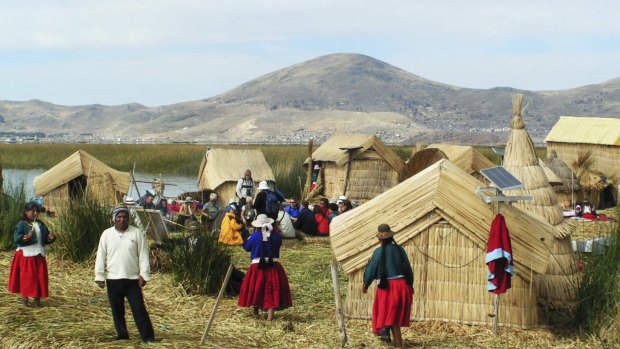
The floating Uros Islands on Lake Titicaca in Peru.Credit: iStock
Peru will be nice when it's finished. This thought rears its ugly head as our minibus trundles through the streets of Puno, a bustling, busy town clinging to the steep foothills of a mountain range on the shores of Lake Titicaca.
Outside, in the warm but alarmingly thin air, barrel-shaped local women in eye-wateringly colourful traditional dress and bowler hats two sizes too small for them go about their business against a backdrop that's nothing short of a construction site. Building after building ends in walls from which protrude rusty reinforcing bars; it's as if they've all got something against the second floor.
Well, explains our guide, in a way they have; and that something is property tax, which becomes due only when you finish building. Hence the curiously Peruvian architectural style known as Constructio Interruptus.
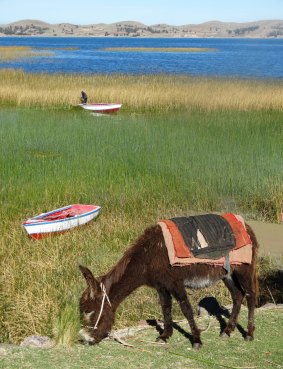
Lake Titicaca.Credit: Keith Austin
Puno, despite its egregious lack of second storeys, is a popular stepping off point for trips out on to Lake Titicaca and inland to the ancient archaeological sites – such as the magnificent above-ground pre-Incan burial towers at Sillustani – that litter the flat hinterland here in the southern reaches of the country.
But for the moment we're heading to something a little more rarified and, after a quick stop to take surreptitious pictures at the local Sunday market (this is THE place to come if you are after supplies of the frighteningly fluorescent yellow Inca Cola soft drink, that's for sure) Puno is soon a dot in the rear-view mirror as we skirt the edges of the world's highest navigable body of water, supposed birthplace of the Incas and home to the world's ugliest frog.
Later research reveals that the frog, which is entirely aquatic and can weigh up to one kilogram, is known officially as Telmatobius culeus, which I think translates roughly as Slapped Scrotum Water Devil, and is endangered thanks to pollution, predation by introduced trout and the belief that it's a natural viagra ("aquatic" obviously means something else in Peruvian).
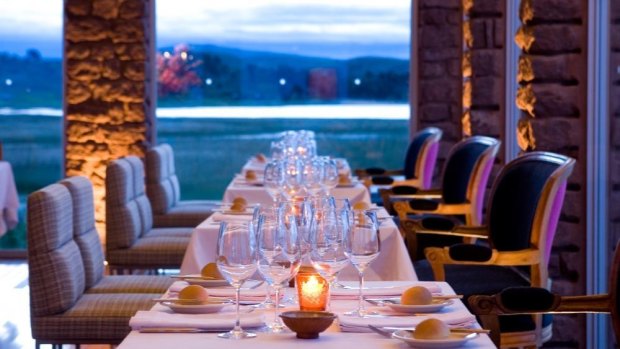
Titilaka is a luxury all inclusive 18 room experience lodge on a remote private peninsula on the shores of Lake Titicaca.
It also probably doesn't help that, according to our guide, the more superstitious locals collect bucketloads of frogs and take them up to the top of the mountain as offerings to the gods when the annual rains are late.
Forty-five minutes later we pull up outside Titilaka lodge, which sits in a wonderful location on a small peninsula at the very edge of the lake. A wooden jetty extends from the rear veranda for all the world like the hotel is dipping a toe into these antediluvian waters.
To be perfectly honest, it's not much to look at from the outside, which is a good thing in this flat, lakeside wilderness where anything flashier, higher or brighter would stick out like a Telmatobius culeus in a beauty contest. It's also got a second floor which is actually finished – a bit of a result in these parts. Understated is the word that springs to mind. As does the idea that Titilaka lodge on Lake Titicaca is a tongue twister up there with Peter Piper and his peppers. Or the setting for a Carry On film.
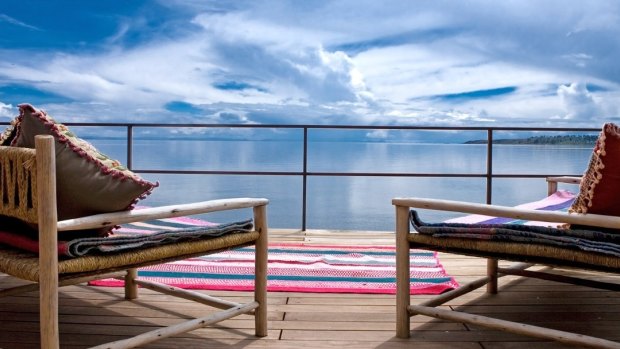
Titilaka is a luxury all inclusive 18 room experience lodge on a remote private peninsula on the shores of Lake Titicaca.
Inside, though, it's a different kettle of ceviche. A member of the prestigious Relais & Chateaux luxury hotel and restaurant organisation, the 18-room, all-inclusive Titilaka lodge boasts a deluxe interior design that is both tasteful and witty. The basic colour palette is a simple, muted organic mix of local stone, wooden floors and pale walls which is then livened up with wonderfully bright splashes of Andean reds, yellows, pinks and greens in throws, rugs, whimsical artworks and furniture. And if you can drag your eyes away from all this, large floor-to-ceiling windows in the public areas and picture windows in the bedrooms take full advantage of the views over the 8372-square-kilometre lake.
According to local legend, Lake Titicaca (the name translates as "grey puma" in the local Quechuan language) is the place where the god Viracocha created the world, as well as being the birthplace of Manco Capac, the first Inca king.
Situated between Bolivia and Peru, with the border running across the southern part of the lake, Titicaca is 190 kilometres long, 80 kilometres wide and has a maximum depth of 284 metres. More importantly, it is 3800 metres above sea level – 1400 metres above the height at which altitude sickness generally kicks in.
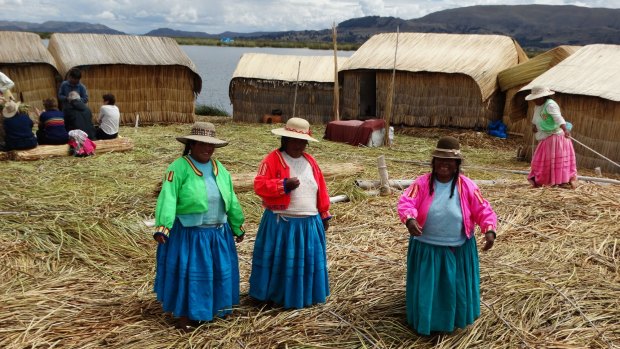
Lake Titicaca and Uru people.Credit: Keith Austin
Symptoms of this include headache, nausea, dizziness, fatigue, shortness of breath, accelerated heartbeat and disturbed sleep – and most people flying directly in to that elevation rather than slowly acclimatising will experience a mild version of some, if not all, of them. Medication such as Diamox can help but it's uncertain who'll be affected and how severely.
The treatment at Titilaka, which we all need to varying degrees, is administered by the lodge's excellent staff and consists of bottled oxygen, aspirin and copious amounts of mate de coca, the local folk remedy tea made with leaves from the coca plant.
After a night slurping coca tea and sucking down oxygen like a frog dying on a mountain top we set out by boat the next morning to visit the Uros people who live on the 40 or so floating reed islands for which the lake has become famous.
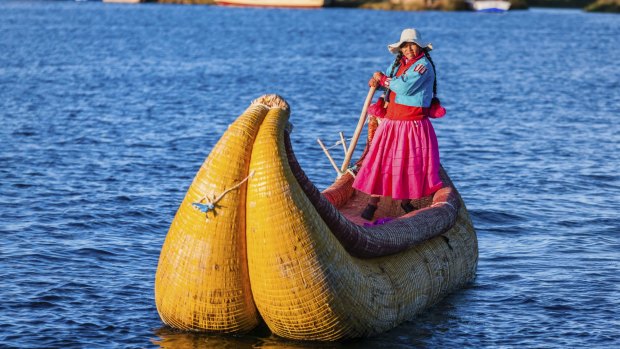
A Peruvian woman sailing between Uros floating islands, Lake Tititcaca.Credit: iStock
Originally created hundreds of years ago for defensive purposes against marauding Incas and the like – it's hard to attack a place that keeps moving about – the islands are essentially large rafts of native totora reeds bundled and rebundled on top of each other over many years.
Many metres thick, and big enough to contain four or five reed huts in which live several generations of a family, the islands bob about like enormous bouncy castles but are anchored to the lake bottom to prevent the inhabitants waking up in Bolivia after a strong wind. Each island, says our guide, takes just over a year to make and lasts 12-14 years before it begins to fall apart.
The Uro-Aymara people who live on them are descendants of the pre-Ican Uros who, according to local legend, existed before the sun, have black blood that prevents them feeling the cold and are impervious to drowning or being struck by lightning – all handy attributes if you're living on a massive lake halfway to heaven.
On arrival at the island we are greeted by a group of women wearing native dress. This consists essentially of startlingly coloured short cardigans embroidered with geometric patterns and coupled with an equally bright pleated skirt called a pollera. Under this they also wear three or four handwoven underskirts which give them a voluminous, rounded look. This is all topped off with big smiles and tiny bowler hats tipped at a rakish angle. It is without doubt the happiest I've ever seen people dressed as Christmas tree baubles. It is a look so bright and cheery that it's impossible not to grin back.
Today the Uros make a living from fishing, weaving and dressing up tourists in their clothes before flogging them miniature reed boats or some colourful hand-made throw/rug like the one I'm sitting on now.
While there we are given a fascinating insight into how the islands are made and also spend half an hour in the company of Eduardo, a softly spoken oarsman who, for 15 soles each, takes four of us across to the local reed beds on one of the distinctively bulbous reed rowboats. Here we discover first-hand that the root of the totora reed is actually edible. Of course, in this case, "edible" simply means eating it won't kill you. It's not going to win any culinary awards but, by gum, it does make a change from yet more quinoa.
Lake Titicaca is also home to the car-free island of Tequile, which is famed for its steep hills, its weaving and the fact that the men there knit their own hats in colours which reveal their marital status. Red and white stripes declare that a chap is single while straight red means "married, hands off".
An approaching storm means we never quite make it up to Tequile's main square where, we are told, there are good cafes and yet more weaving and those soft Peruvian beanies with the earflaps that every backpacker brings back to Australia. Instead, we hightail it back to the hotel through sloppy waves, squally rain and lightning strikes on the horizon.
The rain also puts paid to plans for an evening bonfire so we make do with dinner, drinks around the cosy fire in the lounge and a chaotic game of Cranium during which I learn of the existence of the wonderful word "callipygian" and someone bets me a bottle of single malt that I can't get it into a travel story.
LAN Airlines operates daily from Sydney to Santiago, Chile, via Auckland, with onward connections to Juliaca, the gateway to Puno and Lake Titicaca, via Lima. Fares start at about A$2259 but special offers are available for as little as A$1499. LAN also offers non-stop codeshare flights between Sydney and Santiago four times a week. See www.lan.com or call 1800 126 038.
There is no requirement for vaccinations going in to Peru but returning travellers will be asked for a valid yellow fever vaccination certificate at customs in Australia. See www.lan.com; www.smartraveller.gov.au.
STAYING THERE
Titilaka Lodge has low season double King rooms from A$1055 a night. Visit www.titilaka.com for more details. Excursions are extra.
Keith Austin was a guest of PROMPERU.
Sign up for the Traveller Deals newsletter
Get exclusive travel deals delivered straight to your inbox. Sign up now.